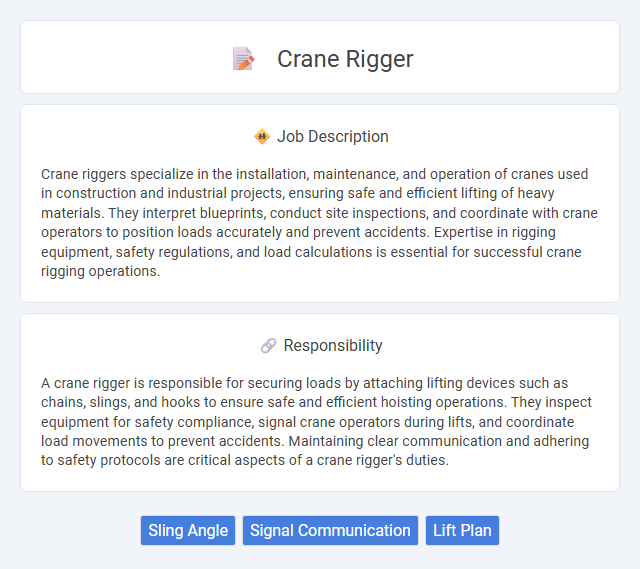
Crane riggers specialize in the installation, maintenance, and operation of cranes used in construction and industrial projects, ensuring safe and efficient lifting of heavy materials. They interpret blueprints, conduct site inspections, and coordinate with crane operators to position loads accurately and prevent accidents. Expertise in rigging equipment, safety regulations, and load calculations is essential for successful crane rigging operations.
Crane riggers are likely to be individuals with strong physical endurance and excellent hand-eye coordination, as the job demands handling heavy equipment and precise movements. Candidates who are comfortable working at heights and in varying weather conditions may find this role suitable, while individuals with a fear of heights or limited physical strength might face challenges. The role probably suits those who thrive in dynamic, safety-critical environments requiring teamwork and acute attention to detail.
Qualification
Crane riggers must possess specialized certifications such as OSHA Crane Certification and NCCCO Crane Operator Certification to ensure safe and efficient operation. Extensive knowledge of load charts, rigging techniques, and safety protocols is essential for handling heavy machinery and materials on construction sites. Physical strength, attention to detail, and experience with various crane types are critical qualifications for success in this role.
Responsibility
A crane rigger is responsible for securing loads by attaching lifting devices such as chains, slings, and hooks to ensure safe and efficient hoisting operations. They inspect equipment for safety compliance, signal crane operators during lifts, and coordinate load movements to prevent accidents. Maintaining clear communication and adhering to safety protocols are critical aspects of a crane rigger's duties.
Benefit
A crane rigger job likely provides substantial benefits including competitive wages and health insurance coverage, which enhance financial security and well-being. Access to retirement plans and paid leave may support long-term stability and work-life balance. Safety training and certification opportunities are probably offered, contributing to skill development and career advancement.
Challenge
Crane rigger jobs likely present significant physical and technical challenges requiring precision and safety awareness. The probability of encountering complex lifting operations and working in demanding environments may test problem-solving skills and adaptability. Mastery of rigging techniques and equipment knowledge is often crucial to successfully navigate these obstacles.
Career Advancement
Crane riggers can advance their careers by gaining certifications such as NCCCO (National Commission for the Certification of Crane Operators) and specializing in different crane types, increasing their expertise and earning potential. Progression often involves moving from entry-level rigging tasks to supervisory roles, where leadership and project management skills become essential. Continuous safety training and technical proficiency open opportunities for higher-paying positions in construction, oil and gas, and heavy manufacturing industries.
Key Terms
Sling Angle
Crane riggers must precisely calculate the sling angle to ensure load stability and safety during lifting operations. A sling angle less than 45 degrees increases tension on the sling, risking equipment failure and load imbalance. Proper training in sling angle measurements directly reduces accidents and enhances overall lift efficiency on construction sites.
Signal Communication
A crane rigger plays a critical role in lifting operations by using precise signal communication techniques to safely guide crane operators. Hand signals, radio communication, and standardized gestures ensure accurate coordination between riggers and operators, preventing accidents and enhancing efficiency on construction sites. Mastery of industry-approved signaling protocols is essential for maintaining safety standards and achieving seamless load movements.
Lift Plan
A crane rigger plays a critical role in executing a precise lift plan to ensure safe and efficient crane operations. The lift plan details load weight, center of gravity, rigging gear specifications, and step-by-step procedures for the hoisting process. Adherence to the lift plan minimizes risks, ensures regulatory compliance, and optimizes the coordination between crane operators and rigging crews.
 kuljobs.com
kuljobs.com